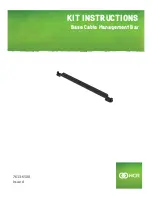
B2342
Emax VF
32/66
Doc. no.
Model
Apparatus
Scale
Page No
1SDH000909R0001
11. Protection releases - General notes
The Emax air circuit-breakers serie is now improved with the PR122/VF, a new variable frequency electronic relay, .
A table can best illustrate the technical features of the relay.
Function/Unit
PR122/VF
Current protections
(L, I)
S
Temperature protection
(OT)
S
Wire communication
(RS485)
S
(1)
Data Logger
S
Compatibility with Ekip Connect
S
PR120/K Signalling
(internal signalling module)
O
PR120/D-M Com
(internal communication module)
O
PR120/DC
(Key plug module)
S
PR030/B
(separate power supply unit)
S
BT030-USB
(separate Bluetooth communication unit)
O
Key:
S
: standard function/unit,
O
: optional function/unit.
Notes:
1. : with PR120/D-M module.
Safety notes
WARNING: this symbol gives information about operations, actions or circumstances that can cause injuries to
the personnel, damage to the unit or economic losses.
Read this manual carefully and completely.
The use of this device should be reserved for qualified and expert personnel only.
If in doubt about its safe usage, the unit must be put out of service to prevent any accidental use.
You must assume that safe usage is impossible if:
1. the unit shows visible signs of damage.
2. the unit does not function (for example with autotest or with the trip test unit).
3. the unit has been damaged in transit.
WARNING: Before putting into service it and/or replacing, the circuit-breaker must be open.
Also remember to disconnect all power supplies connected.
11.1. Notes for dielectric stiffness tests
WARNING: Dielectric stiffness tests must not be performed on releases, inputs or outputs.
To perform impulse insulation tests (e.g. 8 Kv) on the main circuits of an Emax VF circuit-breaker, first disconnect
the PR122/VF-specific connectors XK10, XK11 and XK12, by removing the actual relay as indicated in figure 21 on
page 12 of this manual. It is obligatory to have re-assembled the front protection release before performing the test.
Once the test has terminated, re-assemble the relay with all its connections, check that the connecting screws of the cables
of the terminal boards are tight (0.7 Nm), then proceed with a test cycle as described in sections 8.3.1, 8.3.7 and 8.3.9.
Please consult ABB if further details are required.
















































